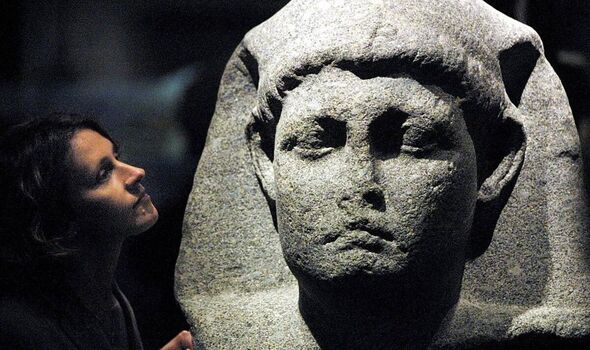World
Archaeologist Discovers Potential Clue to Cleopatra’s Tomb

An archaeologist from the Dominican Republic, Kathleen Martínez, believes she may have uncovered a significant clue to the long-sought location of Cleopatra’s tomb after a two-decade search. Martínez, who transitioned from a career in law to her passion for archaeology, has dedicated her efforts to finding the final resting place of the last pharaoh of Egypt, a figure surrounded by history and intrigue.
Her investigation has focused on Taposiris Magna, a temple located approximately 30 miles west of Alexandria in the coastal town of Borg El Arab. Recent findings by Martínez and her team suggest that this site was not only a religious center but also a bustling maritime trading hub. Their discovery of a sunken port beneath the Mediterranean Sea marks a potential breakthrough in the quest to locate the tomb.
Significant Discoveries at Taposiris Magna
Martínez’s team unearthed a wealth of artifacts and structures dating back to the time of Cleopatra during their excavations in 2022. Among these findings is a remarkable 4,300-foot tunnel leading toward the sea, which contained ceramic jars and pottery from the Ptolemaic period. These discoveries provide compelling evidence that the port was active during Cleopatra’s reign, further supporting the notion that Taposiris Magna could hold the key to her burial site.
“It had all the conditions to be chosen for Cleopatra to be buried with Mark Antony,”
Martínez stated in an interview with National Geographic. Her excitement reflects the potential significance of this location in understanding Cleopatra’s legacy and final days.
Queen Cleopatra VII, born in 69 B.C., became the last ruler of the Ptolemaic dynasty at the age of 18. Her reign was marked by notable relationships, including an eleven-year romance with Mark Antony, which ended in tragedy after their defeat by Octavian, the future Roman Emperor. Martínez believes that Cleopatra sought a secure and hidden place for her body and that of Antony, one that could ensure their safety from Roman forces.
Martínez’s Journey and Methodology
Martínez’s journey to uncover Cleopatra’s tomb began in October 2005, when she narrowed her search to Taposiris Magna, considering all possible temples that Cleopatra could have accessed within a day’s journey from Alexandria. Her meticulous approach combines historical research with modern archaeological techniques, emphasizing the importance of the site’s maritime and religious significance.
The findings at Taposiris Magna not only shed light on Cleopatra’s life but also highlight her role as a powerful figure who influenced the status of women in her time. Describing her as an “extraordinary” character, Martínez notes that Cleopatra excelled in various fields, including philosophy, medicine, and cosmetology.
As the search for Cleopatra’s tomb continues, the discoveries made by Martínez and her team stand as a vital step toward solving a mystery that has captivated historians and archaeologists for centuries. With each new finding, the story of this iconic queen becomes increasingly tangible, potentially allowing us to understand her legacy in a new light.
-

 Health2 months ago
Health2 months agoNeurologist Warns Excessive Use of Supplements Can Harm Brain
-

 Health2 months ago
Health2 months agoFiona Phillips’ Husband Shares Heartfelt Update on Her Alzheimer’s Journey
-

 Science2 weeks ago
Science2 weeks agoBrian Cox Addresses Claims of Alien Probe in 3I/ATLAS Discovery
-

 Science2 weeks ago
Science2 weeks agoNASA Investigates Unusual Comet 3I/ATLAS; New Findings Emerge
-

 Science2 weeks ago
Science2 weeks agoScientists Examine 3I/ATLAS: Alien Artifact or Cosmic Oddity?
-

 Entertainment4 months ago
Entertainment4 months agoKerry Katona Discusses Future Baby Plans and Brian McFadden’s Wedding
-

 Science1 week ago
Science1 week agoNASA Investigates Speedy Object 3I/ATLAS, Sparking Speculation
-

 World2 months ago
World2 months agoCole Palmer’s Cryptic Message to Kobbie Mainoo Following Loan Talks
-

 Entertainment3 months ago
Entertainment3 months agoEmmerdale Faces Tension as Dylan and April’s Lives Hang in the Balance
-

 Science1 week ago
Science1 week agoNASA Scientists Explore Origins of 3I/ATLAS, a Fast-Moving Visitor
-

 Entertainment4 months ago
Entertainment4 months agoLove Island Star Toni Laite’s Mother Expresses Disappointment Over Coupling Decision
-

 Entertainment2 months ago
Entertainment2 months agoMajor Cast Changes at Coronation Street: Exits and Returns in 2025









